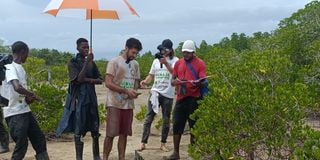Australian seeks to break Guinness world record by planting trees in Kilifi

Jimi Cohen (centre) during a mangrove planting session together with his team in Majoreni, Kwale County on April 22, 2024.
What you need to know:
- Australian national Jimi Cohen, 30, bent effortlessly for more than 23 hours planting mangrove seedlings along the coast in Majoreni, in Kwale County on Monday
- By Monday 12.10pm, Mr Cohen, had planted 30,279 mangrove seedlings, stretching multiple kilometres on the shores of more than one village
- The current world record holder had planted 20, 060 trees in Canada in July 2021
- Mr Cohen said he chose Kenya because most community members are already willing to conserve the environment
A Kenya-based environmentalist, Jimi Cohen, is seeking to break the Guinness World Record by planting the most number of trees by an individual in 24 hours.
As the world marked Mother Earth Day on April 22, the Australian national Jimi Cohen, 30, bent effortlessly for more than 23 hours planting mangrove seedlings along the coast in Majoreni, in Kwale County.
Mangroves are trees that grow on saline water, whose leaves and roots play a critical role in the marine environment.
It all started on Sunday afternoon at exactly 12.10pm, when Mr Cohen and his team from the Kenya Forest Service (KFS), Pongwe- Kikoneni- Majoreni Community Forest Association (CFA) and his organization Tree Gens officially resumed recording on camera.
They also recorded on paper, and tallied the number of seedlings Mr Cohen was planting near other mangrove plantations in the little-known village.
The officials from KFS would mark on a book, while another member of the community would also have his own record, then later compare to ensure the two are tallied.
By Monday 12.10pm, Mr Cohen, had planted 30,279 mangrove seedlings, stretching multiple kilometres on the shores of more than one village. The current world record holder had planted 20, 060 trees in Canada in July 2021.
He says that at his peak, he planted at least 2,000 trees per hour, and the number was reduced depending on his energy.
"I feel satisfied. I feel excited that I have been able to finish this exercise. My target was to plant 30,000 trees, but I have surpassed it. Now I wait for the verification of my results," he said.
This happened as the team who had camped at the site for more than 24 hours, recording day and night, celebrated the completion.
Mr Cohen said he chose Kenya because most community members are already willing to conserve the environment, compared to back in his country where undertaking such practices would put him at risk of wildlife attacks in such forests.

Jimi Cohen (centre) during a mangrove planting session together with his team in Majoreni, Kwale County on April 22, 2024.
He further said the coastal areas provide the best environment for mangrove restoration.
Kenya Forest Service Warden Livingstone Kitawi, who supervised his planting but also provided security for the exercise, said this would complement the service's mission of increasing Kenya's forest tree cover.
"We are excited that an individual could plant this many trees. It shows the commitment by various people to conserve our environment," he said.
Mr Kitawi said such trees will help mitigate effects of climate change on communities.
The planting also came as a blessing to community members of Pongwe Kikoneni Majoreni Community Forest Association (CFA), who got paid Sh1,000 each for the days before and during the planting.
"Our area is one of the most at risk of climate change effects. A greater part of the mangroves in our villages have been cut down while others are sunk in flooded river waters. The restoration will be of great help," CFA Chairperson Mshemanga Hamisi.
He said communities in the Coast region depend on mangroves as a critical ecosystem that supports their livelihoods. For instance, some communities practice beekeeping in the mangroves, while the trees also act as breeding areas for fish.
Cutting down the trees puts them at risk of ocean floods and harsh environmental emergencies such as extremely high and rough tides.
Two weeks ago, residents living along the coast had panicked with fears of being submerged when water from the Indian Ocean rose above sea walls, getting into villages and houses due to high tides.
Meanwhile, despite Mr Cohen's attempts to plant the most trees earlier in Kenya and Tanzania being unsuccessful where his equipment failed, he remains hopeful as he awaits the verification by the Guinness Book of Records, which he says does not come with any monetary reward.
Mr Cohen says he hopes to continue monitoring the trees to ensure there's a high survival rate.




